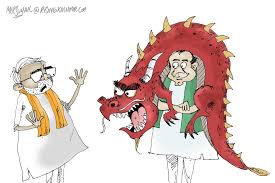Prof. Gull Wani
 Mehbooba Mufti was successful by delaying the government formation, and it was a positive step by her because she by doing so managed public opinion in state of Jammu Kashmir especially in Kashmir. By delaying the government formation Mehbooba tried to manage public opinion, and also make opinion leaders, civil society members, media and intelligential to think over it. While at the same time she was saying to us that the coalition government was an unpopular type of arrangement for us.
Mehbooba Mufti was successful by delaying the government formation, and it was a positive step by her because she by doing so managed public opinion in state of Jammu Kashmir especially in Kashmir. By delaying the government formation Mehbooba tried to manage public opinion, and also make opinion leaders, civil society members, media and intelligential to think over it. While at the same time she was saying to us that the coalition government was an unpopular type of arrangement for us.
If we look at political history, there are many instances where time factor has played a crucial part. When a party delays forming the government many positive things come out by delaying tactics. Same goes for the Peoples Democratic Party (PDP) as well.
On the other hand Mehbooba Mufti did succeeded by resenting for two months. Her delay was justified because at the end of over two months PDP gained its lost ground in many constituencies.
It was the failure of the PDP-BJP coalition government that Governor Narinder Nath Vohra immediately started to resolve issues of the people. Vohra had no magic wand, but the fact is he was watching what was happening in this sensitive state were youth are restless, two diametrical opposite parties were bought together to govern, on ground nothing happening for the common people so Governor immediately addressed the some important issues. Many people also said that same things could have been done by the elected government that was in place during ten months of 2015.
Factors for formation of second PDP-BJP government
These may be counted as the eight Ps.
First, personal factors: It means ambitions family inheritance.
Second, political factors: It means fractured mandate and compulsion of keeping the state together.
Third, the party: It means the party rank and file and the workers and leaders who want a share in political power.
Fourth, promises given to Mehbooba Mufti by Prime Minister Narendra Modi, Finance Minister Arun Jaitley and others, that we will support you.
Fifth, pulls that Mehbooba faced, the danger of splits in her party, and the fear that Modi may get annoyed.
Sixth, phenomenon called BJP. The saffron party under Modi is not only a government but a hard cultural and social phenomenon.
Seventh, pressures that Mehbooba felt within the Kashmir and her constituency.
Eighth, peace building: It means not having an elected government would reduce the peace dividend of the state, and cause hardships to people.
Challenges for the state
As Mehbooba Mufti takes over as the first women Chief Minister of Jammu Kashmir, the state faces major challenges.
Among the youth, the problem is of educated youth who are unemployed, and the uneducated youth.
Drug addiction is an area of concern in the state. There are approximately 70,000 drug addicts, of which about 4,000 are women.
Agrarian distress is high in Jammu Kashmir. The year 2015 saw 30 per cent fall in demand for apple. There is low business confidence. This impacts tourism, which is a security sensitive industry.
Regional and communal polarization has become a major area of concern for Jammu and Kashmir. The state threw up a fractured mandate driven by regional polarization.
The worry is that the fractured mandate may lead to fractured polity, and ultimately cause the break-up of the state.
Domestic politics in Jammu and Kashmir has deep fault-lines. Meanwhile, the state and its frontiers are ideologically vulnerable to the aggressive, hyper Hindu nationalists and forces from the North West (Pakistan & Afghanistan).
How to keep the coalition together
The most important rule of coalition politics is that neither of the two partners should take an extreme stand on any issue. The middle game in coalition politics is important in order to remove friction and avoid contradictions in partnership.
PDP and BJP must form a coordination committee, steering committee, a group of ministers and other such groups and committees to sort out contentious issues.
In order that the coalition is able to complete full term, both PDP and BJP must move from competitive communalism to competitive liberalism. They must steer clear of the regional fault-lines of the state. Their perspectives must change from a regional paradigm to a Jammu and Kashmir paradigm.
How to promote effective governance
Periodic/ timely audit of each ministry by civil society and opinion leaders will help. For example, the education ministry can be audited by those heading the educational sector. The efficiency of the Tourism Ministry may be scrutinised by the major tourism players.
Mehbooba can learn valuable lessons from Bihar under Nitish Kumar, and Delhi under the leadership of Sheila Dixit. In some backward states, the chief ministers have been able to make significant progress, and the reasons for their success should be studied.
Mehbooba has to drive the change that she wants to see in Jammu and Kashmir. She must reward those who deliver, and punish those who falter.
Committed individuals to head departments
Mehbooba must post committed individuals to head the various departments and improve their functioning. For example, the sports and youth affairs ministry plays a vital role, and must be sensitized towards its responsibility to the youth.
It is interesting to note that Madhya Pradesh recently created a ministry of happiness.
The Education Ministry may be renamed as the Ministry of Human Resource Development, so that it may renew its focus towards this vital social task. The Jammu and Kashmir government must also focus on promotion of innovation and skill development.
Author is Director of UNESCO Madanjeet Singh Institute of Kashmir Studies, University of Kashmir and can be mailed at gullwani@gmail.com





